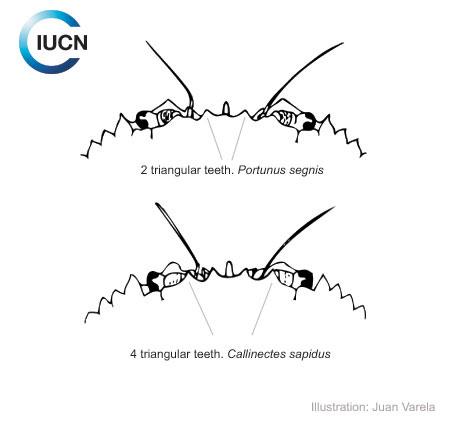Callinectes sapidus
Information
The blue crab lives in estuarine and other shallow coastal waters including coastal lagoons, to a maximum depth of around 90 m. It is found on muddy and sandy bottoms in coastal areas, but moves to greater depths in winter. In its native distribution range, sea grass meadows and macroalgal beds are considered critical nursery habitats.
Migration and reproduction patterns differ between crab populations and little is known for those in the Mediterranean. Mating generally occurs during the warmest months of the year and can occur in brackish habitats, however it can also reproduce in regions with little or no freshwater input. Female usually migrates into the mouths of estuaries or coastal marine waters for spawning. This blue crab has a high fecundity: females may produce up to 2 million eggs per brood.
It can be confused with Portunus segnis, another exotic species that is invading in the Mediterranean. The Atlantic blue crab can be distinguished however by number of frontal teeth on the carapace. C. sapidus has four, while P. segnis has two.
Males of the Atlantic blue crab have claws blue with red tips, while females have orange coloration with purple tips and a carapace without white spots.




The first record of the Atlantic blue crab in the Mediterranean was in 1949 in the Venice lagoon. Since then it has been gradually recorded in various areas in the Mediterranean passing from brackish and coastal waters of the Levantine Sea (Israel, Egypt, Lebanon, Cyprus), Adriatic sea (incl. Albania and Italian lagoons, Croatia), Aegean (Greece and Turkey), Ligurian (Genova), Sicily, Ionian Sea (ca. Ugento) and more recently in Mar Menor lagoon and the Ebro Delta (Spain). Its expansion seems related to the increase of maritime transportation.
The blue crab is is omnivorous, with a diet that includes bivalves (ej. oysters and clams), crustaceans, fish, worms, and also plants, detritus and carrion. It is considered aggressive towards other species, and competes with other crabs for food and space. C. sapidus is also a host to several parasites and diseases.
The Atlantic blue crab is a commercially important species through much of its native range. In some parts of the Mediterranean like in Greece, the Atlantic Blue crab has become the subject of crab fishery and the local population may be decreasing as a result of overfishing. Negative economic impacts have been reported as in some areas it has interfered with fisheries practices, tearing fishing nets or damaging trapped fish.
http://www.fao.org/fishery/species/2632/en
A. Brockerhoff & C. McLay (2011). "Human-mediated spread of alien crabs". In Bella S. Galil, Paul F. Clark & James T. Carlton. In the Wrong Place – Alien Marine Crustaceans: Distribution, Biology and Impacts. Invading Nature 6. Springer. pp. 27–106. ISBN 978-94-007-0590-6.







